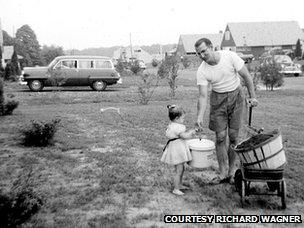Return to Levittown: a suburban dream turns 60
- Published
Levittown's early history in the post-World War II boom (Video by the BBC's David Botti)
Almost 60 years ago, a planned community embodied the hopes and prosperity of America. Now, it represents a more realistic picture of the American experience. The BBC investigates Levittown, Pennsylvania, as part of a year-long series.
In 1960, BBC journalist Ludovic Kennedy travelled to Levittown, Pennsylvania in advance of the Nixon-Kennedy election. Reporting for Panorama, Kennedy's on-the-scene accounts provided an ideal perspective from which to measure the concerns of a fast-changing nation.
Levittown had been founded eight years earlier, when America was on the cusp of a huge burst of prosperity. GIs home from the war had started families in earnest. The baby boom had begun, and a new middle class was driving the economy.
For the first time, people who once rented apartments in the city could afford a modest home of their own.
"The people who moved into these places initially weren't in the professions: doctors, lawyers bankers," says Gary Cross, professor of history at the Pennsylvania State University.
"It was creating the opportunity for people to own a house instead of rent, and do so for the same amount of money," he said. In doing so, Levittown helped solidify the idea of America as the place where anyone could make it, if only they worked hard enough.
For journalists like Kennedy, Levittown was a metaphor for American prosperity and the emerging middle class. When he visited, the mix of Catholic, Jewish, and Protestant neighbours represented the melting pot ideal of the US, while also allowing easy shorthand for the suburban revolution that was spreading across the country - a strong, growing demographic that had the power to shape the election.
The BBC visited Levittown in 1960 as residents campaigned for the presidential candidates
Changing times
In 2012 Levittown will turn 60. And just as when Panorama visited, the country will hold a contentious presidential election.

Many of Levittown's first residents were young families
Now, as then, the community is home to a diverse cross-section of middle-class voters. But whereas in 1960 unemployment rates were less than 6% and business in Levittown could not expand fast enough to meet growing demand, the outlook for current residents is grimmer.
"The economy has been hard on all of us," says Levittown resident Lillian Wilson. Now a senior citizen, Ms Wilson spends her days at the thriving senior centre near her home. She was one of the first residents of Levittown, buying her home before it was even built.
When she first moved in, milk and egg men delivered to her door - a good thing, as there was nowhere else to buy groceries. The house she moved into had a strict modification policy, just like every other house in the development.
Though Levittown was often marketed as a suburban ideal, that ideal could not include white picket fences - or fences of any kind. "We couldn't even have a clothes line," says Ms Wilson.
"Levitt was very serious about all of the houses looking the same," she says, referring to William Levitt, the real-estate developer who built three separate Levittowns in the post-war boom: one in New York, one in Pennsylvania, and one, later called Willingboro, in New Jersey.
Now, the outer roads around Levittown are lined with strip malls, and in them a dozen different grocery and convenience stores, a Super WalMart, McDonalds, and hotel chains.

Levittown homes came with modern appliances, such as in this kitchen of a Levittowner model home
The houses, once indistinguishable from one another, have developed individual flair: on one street, one house has painted pink brick face, while another has built a covered front porch.
Several residents enclosed their car port, creating either a proper garage or an additional room, while some have added second-storey additions onto the classic ranch-style houses - one of four home models available to the original buyers.
The subdivisions, with names like Junewood and Goldenridge, were once considered diverse for their mix of German, Hungarian, Irish and Polish residents, though residents started a riot when the first black family moved in.
Now Ms Wilson has black, Indian, and Puerto Rican neighbours.
<bold>Returning to Levittown</bold>
Levittown is far from a monolithic community, straddling four different townships.
Neighbourhoods fortunate enough to fall in a wealthier area flush with tax revenues have pristine sidewalks and well-manicured public spaces. In other areas, more than one home displays prominent sheriff's stickers and No Trespassing signs, indicators of foreclosure and economic distress.
Residents include Levittown's original settlers, like Ms Wilson, who came to the community a young bride and has children and grandchildren who still live close by.
It's not a greying district by any means - thanks in part to the housing collapse, Levittown is once again an abundant source of inexpensive housing, and as a result more new families are moving here to get their start.
The community has changed, and continues to change, since the BBC first visited it more than a half-century ago.
The country has changed much, as well. But one thing has not: the middle class residents make up the heart of America, and are still viewed as the "real" voice of the nation. Candidates vie to win their vote, and politicians battle over who best represents their interests.
So like Ludovic Kennedy before us, the BBC will turn to Levittown for insight into what matters most to Americans.
As Levittown prepares to turn 60 and the nation prepares to vote in the next presidential election, the BBC will focus on Levittown in depth. For the next year, we will meet its citizens, documenting their concerns and dreams, and tell the stories of residents who used to inhabit the American Dream.